E&P expenditures in the US are indicated to rise by 12%, a somewhat surprising magnitude given weak natural gas fundamentals.
James D. Crandell, James C. West, Nicholas McLean and Anthony Walker, Barclays Capital
Barclays Capital’s Oil Service and Drilling section issued its semi-annual spending survey on Dec. 16, 2009. The 32-page report includes responses from 387 companies analyzing spending for 2009 and planned expenditures for 2010. The report focuses on the US, Canada and regions outside North America. The data includes 39 tables and figures with Barclays Capital’s comments, survey findings, the survey process and results, as well as company observations.
“The Original E&P Spending Survey” attempts to include every meaningful spender on exploration and production throughout the world, which encompasses integrated oil companies, independents and national oil companies worldwide.
The survey indicates that worldwide E&P Capex budgets will increase by 11% in 2010 to $439 billion from $395 billion in 2009. North American budgets have the largest gains year-on-year, but spending elsewhere is also expected to show a double-digit increase. This follows a decline during 2009 in which E&P spending dropped 31% in the US, 33% in Canada and 6% outside North America.
Capital expenditures in the US are projected to rise 12% in 2010 to $79 billion from $71 billion in 2009, according to 197 companies surveyed. Canadian Capex is forecast to increase by 23% to $23 billion in 2010 from $19 billion in 2009, by the 126 companies surveyed. This follows a sharp fall in spending in 2009, when North American capital expenditures declined due to the collapse in commodity prices and difficult credit markets. North American independents are highly sensitive to commodity prices and cash flow, and adjust budgets quickly as industry conditions warrant.
Expenditures outside North America are estimated to increase by 10% this year, resuming the trend of growth that has seen international capital expenditures rise in 10 of the last 11 years. A rise in spending to $337 billion, from $305 billion in 2009, is expected by the 134 companies surveyed. The majority of the increase in capital spending will be by national oil companies.
2010 BUDGETS FORECAST UP 12% IN THE U.S.
In a reversal of the decline in Capex in the US in 2009 (which was triggered by falling commodity prices and tight credit markets), spending budgets in 2010 are expected to rise by 11.7% to $79.5 billion from $71.2 billion in 2009. A large portion of the incremental spending is directed at shale plays, with some capital also shifted toward oil-related activity. Traditional vertical well drilling (such as in the shallow-water Gulf of Mexico and onshore Gulf Coast) is not expected to participate in the upturn. We are surprised at the magnitude of the increases to US budgets and believe that the additional production that is anticipated as a result of these increases could put US natural gas prices under pressure and may lead to another drilling downturn—perhaps as early as the second half of 2010.
Of the 197 companies with spending in the US, 80 (or 41%) are estimated to increase spending by more than 50% in 2010. Thirty-seven companies (19%) are expected to increase spending by between 10% and 30%. Fifty-two companies (26%) are estimated to keep Capex relatively flat year-on-year (within ±10%). Thirteen companies (7%) are expected to cut Capex by 10–30% this year, and 15 companies (8%) are expected to cut Capex by more than 30%.
Among the larger companies that we estimate will have significant budget increases in 2010 versus 2009 are Chesapeake Energy (up 40%), Devon Energy (up 45%), EOG Resources (up 21%), Hess Corp. (up 55%), Noble Energy (up 36%), Range Resources (27%) and SandRidge Energy (up 54%)—all of which are expected to spend over $600 million. Conversely, large companies that we estimate will reduce their 2010 US Capex budgets include ConocoPhillips (down 23%), Royal Dutch Shell (down 9%), Plains Exploration and Production Company (down 40%) and Williams Companies (down 8%).
| 2009–2010 selected “supermajor” international budgets, $ million |
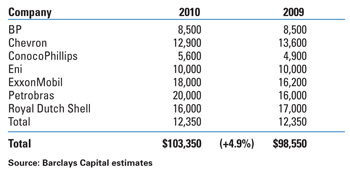 |
2009–2010 selected North American independents’
international budgets, $ million |
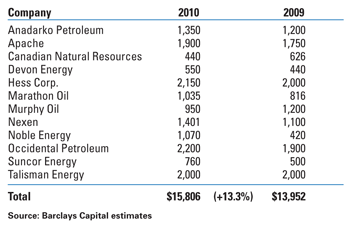 |
| 2009–2010 US E&P expenditures, $ million |
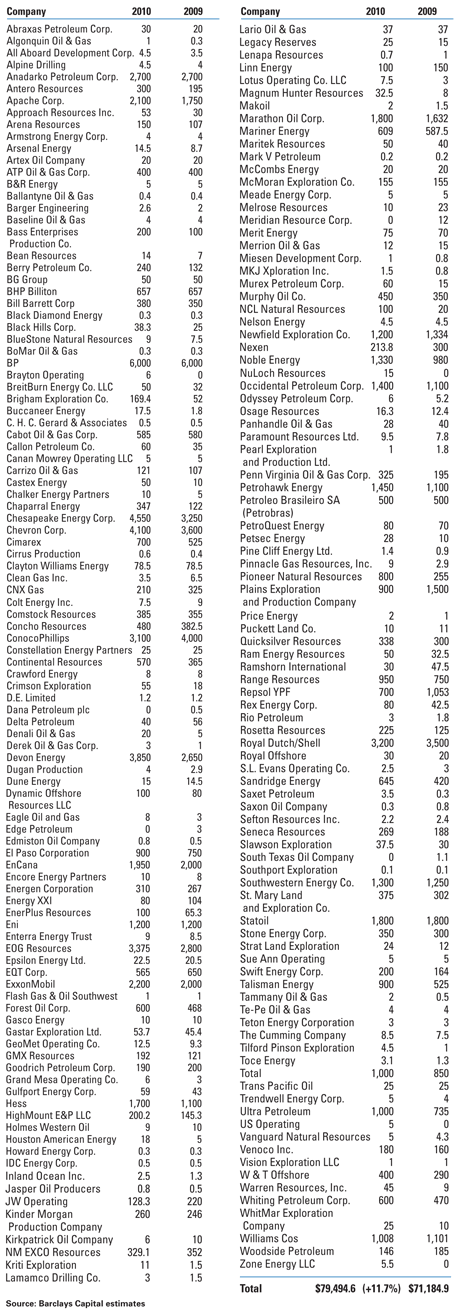 |
SHARP RISE IN CANADIAN SPENDING ESTIMATED IN 2010
In recent years, Canadian E&P spending has lagged that in the US and outside North America. However, the country’s 2010 Capex is slated to increase significantly—up by 23% to $23 billion in 2010 from $19 billion in 2009, according to the 126 companies surveyed. However, since our survey is measured in US dollar terms, this strong performance is due in part to the appreciation of the Canadian dollar versus the US dollar. We estimate that slightly less than half of the increase in Canadian spending is attributable to currency fluctuations; excluding this, the increase in capital spending in the US and Canada is similar (with both up about 12%).
Among the larger companies that we estimate will have the greatest budget increases are Imperial Oil (up 50%), Canadian Natural Resources (up 64%), Cenovus Energy (up 33%), Penn West Energy Trust (up 38%), Murphy Oil (up 71%), ARC Energy Trust (up 75%) and Petrobank Energy and Resources (up 67%). Conversely, large companies that we estimate will cut their 2010 Canadian Capex budgets include Royal Dutch Shell (down 10%), ConocoPhillips (down 29%) and Nexen (down 27%).
| 2009–2010 Canadian E&P expenditures, $ million |
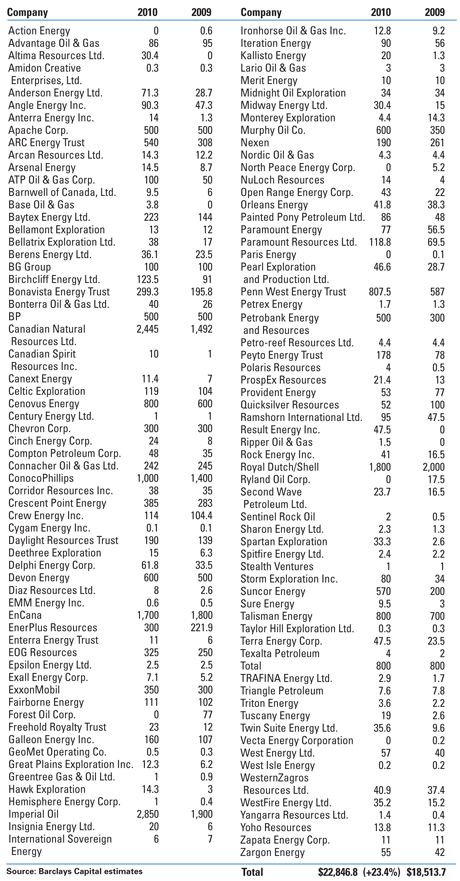 |
INTERNATIONAL SPENDING RETURNS TO GROWTH IN 2010
International Capex is forecast to rise by 10% this year to $337 billion from $305 billion, by the 134 companies surveyed. Large Asian, Middle Eastern, Russian and African companies show some of the largest increases internationally, while spending for European firms and supermajors is generally flattish year-on-year. We believe the international spending totals for 2010 are above consensus estimates and are also above previous forecasts.
| 2009–2010 international (outside North America) E&P expenditures, $ million |
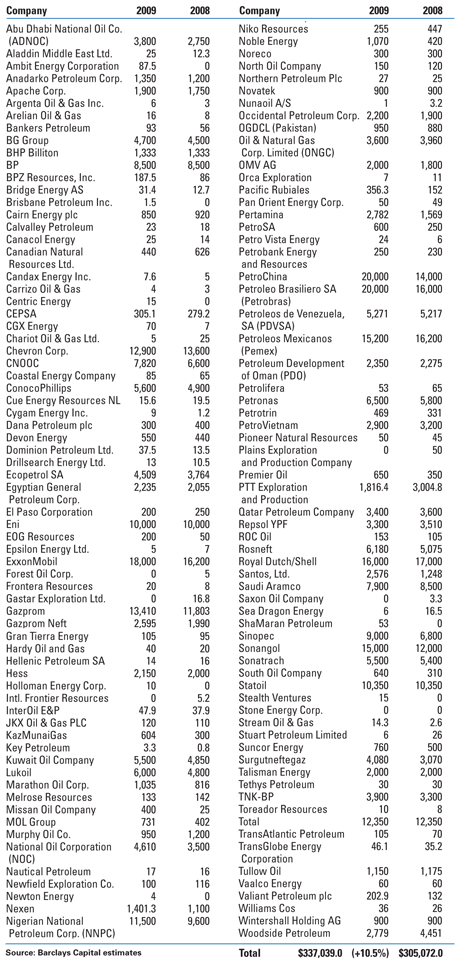 |
Supermajors. In general, we anticipate minor spending increases for the supermajors this year, with the big six expected to increase international spending by about 1% in the aggregate. We forecast that BP and Total will maintain their spending relatively flat, while ConocoPhillips and ExxonMobil are anticipated to increase their international spending by 14% and 11%, respectively. Conversely, both Chevron and Royal Dutch Shell are estimated to reduce international spending this year by 5% and 6%, respectively.
Middle East/Africa. We estimate that capital spending by selected Middle Eastern and African firms in 2010 could be up by 15% year-on-year. In the Middle East, Abu Dhabi National Oil Company (ADNOC) and Kuwait Oil Company are expected to show double-digit increases in capital spending in 2010. However, spending by Saudi Aramco and the Qatar Petroleum Company is expected to be down modestly (–7% and –6%, respectively). In Africa, spending by Nigerian National Petroleum Corp. (NNPC), Angola’s Sonangol and Libya’s National Oil Corporation (NOC) is forecast to be up significantly.
Iraq’s three NOCs—North Oil Company, South Oil Company and Missan Oil Company—are also expected to increase spending significantly this year. This is the first time these three companies have appeared in our survey. Many of the large national and international oil companies that have been awarded projects in Iraq do not include spending on these Iraqi oil fields in current E&P budgets for 2010. This spending would be mostly incremental to these regional spending gains. We believe that Iraq could be one of the fastest-growing markets for oil service companies over the next several years.
Russia. Russian companies showed some of the largest cuts to E&P Capex in 2009, but indications are that Russian firms could be among the more aggressive spenders in 2010. Gazprom, Gazprom Neft, Lukoil, Rosneft, Surgutneftegaz and TNK-BP are expected to show double-digit increases in spending, while spending by Novatek is expected to be flattish this year. On average, spending by the Russian companies is expected to rise by 20%—this compares with a sharp drop of 30% in spending levels in 2009.
Asia and Australia. Trends for state-owned and international oil companies based in Asia and Australia are somewhat mixed, but overall we forecast a significant increase in Capex this year (+18%) for these companies. Although we forecast declines for some companies, such as India’s ONGC, PetroVietnam and PTT E&P, big increases are expected for China’s CNOOC, PetroChina and Sinopec. Likewise, spending by Malaysia’s Petronas and Indonesia’s Pertamina is expected to be up significantly. We also believe spending by the major oil companies in Australia is set to rise.
Latin America. Increased spending in Latin America is being driven by ambitious capital spending plans by Petrobras (up 25%). In addition, Petrotrin and Ecopetrol are also expecting large gains. Spending by Venezuela’s PDVSA and Mexico’s Pemex, however, is expected to lag. Capex for PDVSA is anticipated to be flattish in 2010, while Pemex spending is forecast to be down 6% year-on-year.
Europe. Most European-based companies appear to be increasing spending only modestly in 2010, if at all. Aggregate spending for European firms is forecast to be flattish year-on-year. Spending increases by such firms as MOL Group and Premier Oil are largely offset by declines for Repsol and Dana Petroleum.
INTERNATIONAL SPENDING BY NORTH AMERICAN-BASED FIRMS
Independents based in North America invest the bulk of their capital in their home countries, but in recent years these companies have shifted funds from domestic to international operations. We forecast spending increases for most North-American-based independents (and smaller integrateds), with aggregate investment expected to be up 13% year-on-year.
RESPONSES
We asked the companies in our survey a number of questions about their budgets. The results of these questions follow:
-
Fully 45% of respondents anticipate spending a greater share of Capex on exploration in 2010 versus 2009; just 16% spent a greater proportion of capital spending dedicated to exploration in 2009. This is a clear positive for seismic companies and also a positive trend for the major oil service companies.
-
The overall E&P spending decline in 2009 appears to have been generally in line with the decline forecast in our midyear 2009 survey. We estimate that total spending fell by 15% in 2009.
-
Companies are basing their 2010 E&P budgets on a crude oil price of about $70.13 per barrel (WTI). This average oil price assumption is above the $50.18 per barrel indicated in our midyear survey and the $58.30 per barrel in last year’s survey. The most frequently cited price that would result in a cut in E&P budgets is $50 per barrel for oil (WTI).
-
The average natural gas price associated with 2010 E&P budgets is $5.21 per Mcf (Henry Hub). This compares to the average natural gas price assumption indicated in our midyear survey of $4.68 and $6.35 in last year’s survey. The natural gas price at which many respondents would begin to cut budgets is $4.00 per Mcf, and a larger percentage are prepared to cut budgets at $3.00 per Mcf.
-
The vast majority of companies we surveyed (74%) expect to spend within their cash flow during 2010. This represents an increase versus the prior year; during 2009, 63% of companies expected capital expenditures to be within cash flow.
-
Some 42% of companies indicated that challenging credit market conditions affected Capex plans last year. A smaller percentage of respondents (32%) expect difficulties in the credit markets to impact spending in 2010.
-
For the fifth year in a row, natural gas prices were highlighted as the most important determinant of E&P spending in the coming year, followed by cash flow. Notably, the percentage of respondents citing capital availability as a key determinant has increased for the second straight year (to 35% from 29% in 2009 and 23% in 2008), while the number of companies highlighting drilling costs, drilling success and prospect availability decreased for the second year in a row.
-
Exploration economics continue to be viewed as best outside North America, while the outlook for exploration in North America continues to diminish.
-
For the second consecutive year, fracturing/stimulation and horizontal drilling were most commonly cited among operators as having the greatest impact on their business. Given that stimulation technology and horizontal drilling are the main technologies used in unlocking shale plays, this is not surprising. Third place in this year’s ranking went to 3D/4D seismic.
Editor’s note: It is not statistically accurate to compare total estimates with those from prior years because the companies surveyed vary from year to year. 
|







